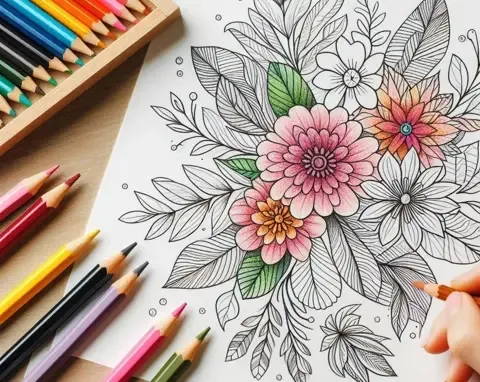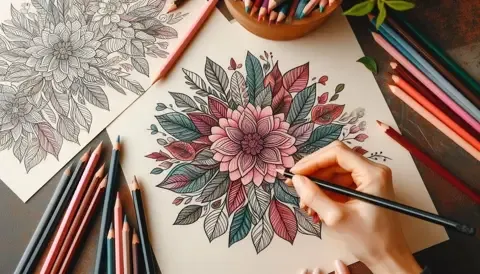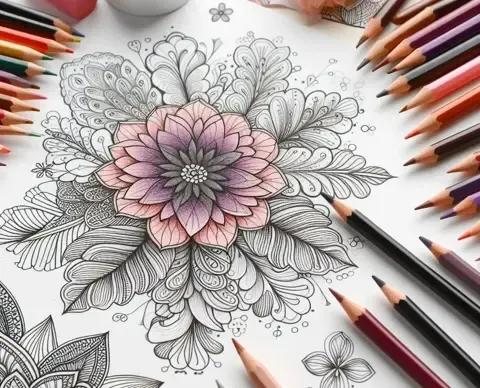Colored Pencils for Beginners
A Comprehensive Guide to Getting Started with Colered Pencils
Introduction
Colored pencils are a versatile and accessible medium suitable for artists of all skill levels.
Whether you're a complete beginner or an experienced artist looking to refine your techniques, understanding the fundamentals of colored pencils is essential for creating beautiful and vibrant artwork.
They provide a unique opportunity to produce intricate, colorful compositions with precision and control.
This comprehensive guide covers everything you need to know, from selecting the right materials and mastering basic techniques to exploring advanced methods that will help you achieve professional-quality results.
Additionally, it will provide tips to help you avoid common mistakes and make the most of your creative journey.
1. Choosing the Right Colored Pencils
Selecting the right colored pencils is a foundational step that can significantly impact the outcome of your artwork. With so many options available, it's important to understand the different types, qualities, and features that suit your artistic style and goals. Choosing high-quality pencils can make blending easier and enhance the richness of your colors.
1.1 Wax-Based vs. Oil-Based Pencils
Wax-Based Pencils: These pencils have a soft, smooth core that glides effortlessly on paper, making them ideal for blending and layering. Their rich pigmentation allows for vibrant results, and they are generally more affordable, making them a popular choice for beginners. However, they may be prone to wax bloom, a hazy effect that can develop over time. Proper storage and occasional buffing can help reduce this effect. Popular brands include Prismacolor Premier and Crayola.
Oil-Based Pencils: These pencils contain an oil binder, making them slightly harder and more durable. They allow for fine details and precise layering without the wax bloom issue. Their vibrant colors and superior lightfastness make them a preferred choice for professional artists. Notable brands include Faber-Castell Polychromos and Lyra Rembrandt. They may require a bit more effort to blend but provide excellent control and durability.
1.2 Student-Grade vs. Artist-Grade
Student-Grade: These pencils are a cost-effective option, offering a wide range of colors and decent performance for beginners. They are ideal for practice and experimentation, though they may lack the pigmentation and blending capabilities of higher-end options. They are a good starting point for those learning basic techniques.
Artist-Grade: Designed with professional artists in mind, these pencils provide richer pigments, smoother blending, and greater lightfastness, ensuring your artwork remains vibrant over time. Though more expensive, they offer a superior drawing experience and long-lasting quality that is worth the investment for serious artists.
1.3 Other Considerations
Core Hardness: Softer cores allow for smooth blending and vibrant color application, while harder cores provide greater control and precision for intricate details. Depending on your style, you may want a mix of both types.
Color Variety: Investing in a larger set can give you more creative freedom, but starting with a basic set of essential colors can help you build foundational skills. Many artists prefer sets that include a good mix of warm and cool tones.
Ergonomics: Consider pencils with a comfortable grip and weight that suit your drawing style, especially for extended use. Some pencils have triangular barrels for better grip and control.
By understanding these factors and experimenting with different types, you'll find the colored pencils that best complement your artistic journey and help you achieve the desired results.
2. Essential Supplies
In addition to colored pencils, having the right accessories will improve your experience and help you achieve better results. Proper supplies can enhance your workflow and make your drawing sessions more enjoyable.
2.1 Paper Selection
- Choose smooth, heavyweight paper such as Bristol or drawing paper for best results. This type of paper allows for smooth blending and layering, making it easier to achieve even color application and fine details.
- Textured paper can add unique effects but may require more layering to achieve smooth transitions. It provides a more artistic, organic feel that works well for expressive styles and landscapes.
- Watercolor paper can also be used for mixed media techniques, allowing you to experiment with blending using water-soluble pencils. Experimenting with different paper types can help you find the best surface for your style.
2.2 Sharpeners
- Use a high-quality sharpener to maintain fine points without breaking the core. A dull blade can cause frustration and waste valuable pencil material.
- Manual sharpeners offer greater control, allowing you to adjust the point length based on your drawing needs.
- Electric sharpeners provide speed and convenience, especially for large-scale projects, but be cautious as they can over-sharpen softer cores and lead to waste.
- Knife sharpening techniques are also an option for those who prefer a custom point shape.
2.3 Erasers
- A kneaded eraser helps lift color and create highlights without damaging the paper surface. It is moldable and great for subtle adjustments.
- A precision eraser can be useful for fine details and correcting mistakes, allowing for better control in intricate areas.
- Electric erasers provide a powerful option for precise erasing and creating texture, especially when working with dense layers of color.
2.4 Blending Tools
- Blending stumps and tortillons help soften lines and create smooth transitions between colors.
- Cotton swabs and tissues can be used for gentle blending to achieve a painterly effect.
- Solvents like odorless mineral spirits can break down the wax binder and create a soft, smooth finish that resembles paint.
- Burnishing tools can help achieve a polished, professional look by compressing the pigment layers.
By equipping yourself with these essential supplies, you'll enhance your drawing process and open up new creative possibilities, making your colored pencil experience more enjoyable and productive.
3. Basic Techniques for Beginners
Mastering fundamental techniques can significantly enhance your colored pencil skills and help you create more realistic and polished artwork.
3.1 Layering
- Build colors gradually by applying multiple light layers instead of pressing hard initially. This technique allows for greater depth and richness in color while preventing damage to the paper.
- Experiment with layering complementary colors to create natural gradients and enhance realism.
- Vary the direction of your strokes with each layer to avoid visible lines and achieve smoother transitions.
- Practice patience—layering takes time, but the results can be stunning with a well-built color foundation.
3.2 Blending
- Use a blending pencil, cotton swab, or tissue to smooth out colors and create seamless transitions between shades.
- Try burnishing by applying a lighter color or a white pencil over darker layers to achieve a glossy, polished finish.
- Experiment with colorless blenders, which can help merge colors without adding additional pigment.
- Solvents such as odorless mineral spirits can break down the wax binder, creating a soft, almost painterly effect when used sparingly.
3.3 Hatching and Cross-Hatching
- Use parallel or intersecting lines to add texture, depth, and shading effects to your artwork.
- Experiment with different line densities and angles to achieve unique shading results and stylistic effects.
- Cross-hatching with multiple colors can create vibrant textures and more dynamic shading.
3.4 Pressure Control
- Adjust the pressure applied to create variations in color intensity and shading effects, from soft pastel tones to rich, vibrant hues.
- Practice transitioning from light to dark by gradually increasing pressure while maintaining control over the pencil.
- Use light pressure for sketching and initial layers, then gradually increase for details and final touches.
By mastering these fundamental techniques, you'll build a strong foundation that allows for greater creativity and control in your colored pencil artwork.
4. Common Mistakes to Avoid
Beginners often encounter challenges that can hinder progress. Being aware of these common mistakes can help improve your technique and avoid frustration:
Pressing Too Hard: Applying excessive pressure can lead to wax buildup, making blending difficult and leaving indentations in the paper that are hard to fix.
Skipping Layering: Rushing to achieve vibrant colors without building layers gradually can result in a lack of depth and realism in your artwork.
Using the Wrong Paper: Low-quality paper can absorb pigments unevenly, affect blending, and cause colors to appear dull and washed out.
Ignoring Proper Sharpening: A dull pencil tip can create rough lines, cause uneven coverage, and lead to unnecessary frustration while drawing.
Overblending: Excessive blending can muddy colors and reduce the vibrancy of your artwork, making it look flat and lifeless.
Neglecting Lightfastness: Using non-lightfast pencils may result in faded colors over time, affecting the longevity of your work.
By avoiding these pitfalls and adopting best practices, you'll enhance your colored pencil skills and produce more refined, vibrant artwork.
5. Beginner-Friendly Projects
Starting with simple projects can help build confidence and allow you to practice essential skills. Here are a few beginner-friendly ideas to get you started:
5.1 Coloring Books
Coloring books provide an excellent starting point for beginners. They offer pre-designed illustrations that allow you to focus on shading, blending techniques, and controlling color application without the pressure of creating original designs. Look for books with thick, quality paper that can handle layering and blending without smudging.
5.2 Still Life Drawing
Drawing everyday objects such as fruits, flowers, or household items can help you understand shape, light, and shadow. This practice improves shading techniques and color transitions, allowing you to experiment with various pencil pressures and layering methods to create realistic effects.
5.3 Gradient Exercises
Practicing smooth transitions from light to dark shades can improve your control and blending techniques. Try creating a gradient chart using a single color and gradually increase pressure to deepen the shade. You can also experiment with blending two or more colors to see how they interact and create seamless transitions.
5.4 Nature Sketching
Nature offers an endless source of inspiration with organic shapes and textures. Sketch elements such as leaves, trees, and landscapes to practice layering and detailing. This allows you to explore various textures, from the softness of petals to the rough bark of trees, helping you develop a greater understanding of color and form.
5.5 Abstract Art
Exploring abstract designs and patterns is a great way to familiarize yourself with colored pencils without the constraints of realism. Experiment with bold colors, shapes, and textures to build confidence and develop your artistic style.
By working on these beginner-friendly projects, you'll gradually improve your technique, build confidence, and discover the unique possibilities colored pencils offer.
6. Tips for Improvement
- Improving your colored pencil skills takes practice and patience. Here are some tips to help you grow as an artist:
- Practice regularly to develop muscle memory and confidence in your strokes.
- Experiment with different brands and techniques to discover what works best for your style and preferences.
- Take inspiration from other artists and tutorials to learn new styles, techniques, and approaches that can expand your creative possibilities.
- Keep a sketchbook to track your progress, test new ideas, and explore different subjects without pressure.
- Learn color theory to understand how colors interact, helping you create harmonious and visually appealing compositions.
- Set specific goals such as mastering a particular technique or completing a detailed project to stay motivated and measure your progress.
- Seek feedback from other artists to gain new insights and improve your work through constructive critique.
Final Thoughts
Colored pencils offer endless possibilities for creativity, and with practice, you'll be able to create stunning works of art. By investing in the right supplies, mastering basic techniques, and avoiding common pitfalls, you'll be well on your way to becoming a skilled colored pencil artist.
Whether you're drawing for relaxation, creating professional illustrations, or simply enjoying the process, colored pencils are a wonderful medium to explore. So grab your pencils, experiment with different styles, and enjoy the artistic journey!










0 comments